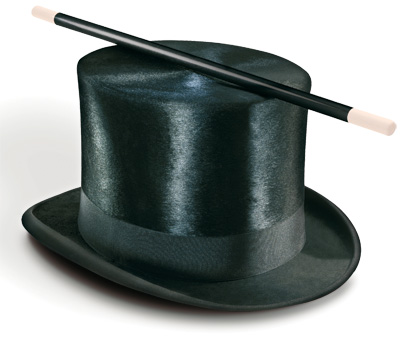A librarian’s ability to find quality texts, like all good magic acts, blends art and science to amaze the audience. We can accomplish things with Google and databases that exceed the ability of the average user. But should we keep this magic to ourselves?
Performers Penn and Teller have built their careers on the novel idea of divulging the secrets behind their magic tricks. If there are no secrets, how can there still be magic? The real power here is the ability of the practitioner to connect with his audience. Even when the science is revealed, the art remains the critical part of the show. Watching Penn and Teller perform what they’ve explained stays magical because of their passion and expertise.
 The same holds true for librarians—giving away the secrets of our information-finding powers will only enhance our value within the school community. So plan time this summer to figure out how to share your search secrets.
The same holds true for librarians—giving away the secrets of our information-finding powers will only enhance our value within the school community. So plan time this summer to figure out how to share your search secrets.
That’s exactly what most schools need right now. For teachers to meet the Common Core guidelines, they must locate high-quality “complex texts,” a key ingredient of the new educational standards.
Local teachers recently attended a CC workshop to learn about the elements that comprise a complex text and “close reading.” They soon realized that they had no idea where to find the texts that were the basis of everything they had learned. So I was asked to lead a daylong workshop on the topic. Here are my secrets.
1. Don’t search—find. Instead of spending time searching databases or your catalog for a topic, go directly to the known sources. Most databases enable you to browse or search for specific titles and then, from the magazine or journals page, to search within that publication. Take Cobblestone, an American history magazine for kids ages 9 to 14. If I wanted a close reading text on the Civil War, I would see what I could find within Cobblestone, rather than waste time in a general search. I’ve already determined that the results from Cobblestone are going to provide the items with the quality and complexity I’m looking for, so I only have to evaluate for content.
2. Look to the experts. Today, expertise is more widely available than it’s ever been. Without cost or even leaving my desk, I can take courses from MIT or Harvard through the edX partnership. As a librarian, I know how to mine the course materials to see what authors, journals, and other resources are being used. These college resources would likely fit the bill for close-reading exercises for high school students.
3. Embrace outsourcing. Outsourcing some non-instructional tasks, if possible, will give you more time to work directly with teachers and students and position yourself as a curricular and pedagogical consultant at your school. We regularly do this; when was the last time that you went down a list of journals to pick the ones you wanted to show up in your online database? The great “In Context” features in Gale/Cengage reference products are a form of outsourcing, as is the expert selection of books by Junior Library Guild. Don’t dismiss the power of experts. Leverage them in your research tasks.
What we librarians do is magic, or at least it seems that way when we quickly produce the book or resource that a teacher’s been searching for. Think of how powerful it will be to share with them how it’s done.



Good point about finding, not searching. I know that I enjoy the “game” and “mystery” aspect of searching- sometimes too much. I often search and search and search and come up with dozens of finds, but it takes time. It’s a better use of time to go to the sources I already know and start there. I usually end up using those anyways.
Usborne Books & More provides K-12 supplemental materials to support educators as they implement these new Common Core State Standards (CCSS). We’ve made the selection process easy- all Usborne and Kane Miller titles are aligned with the standards.
As an endorsing partner of CCSS, Usborne Books & More will help schools and families choose books to help educate their children, both within the school setting and at home. Certain topics mandated by these standards include myths, stories from around the world, and informational text.
The Illinois School Library and Media Association, ISLMA, website has a fantastic tool for school librarians. It is titled I-SAIL because at the time the document was titled Illinois Standards Aligned Instruction for Libraries. Today this same document has the Common Core aligned with library benchmarks for school librarians to use. Go to the ISLMA website, http://www.islma.org, and click on the I-SAIL link. There is a link for a template you can use for your daily lesson plans, this is my example on the website so please feel free to download and use it for your lessons!!!
Thanks, Chris, for these great tips.
To streamline your lesson planning, here is the link to the crosswalk of the Common Core and the national AASL Standards with a link to the Lesson Plan database at the bottom of the page: http://www.ala.org/aasl/guidelinesandstandards/commoncorecrosswalk
We can make it happen and lead with the Common Core!